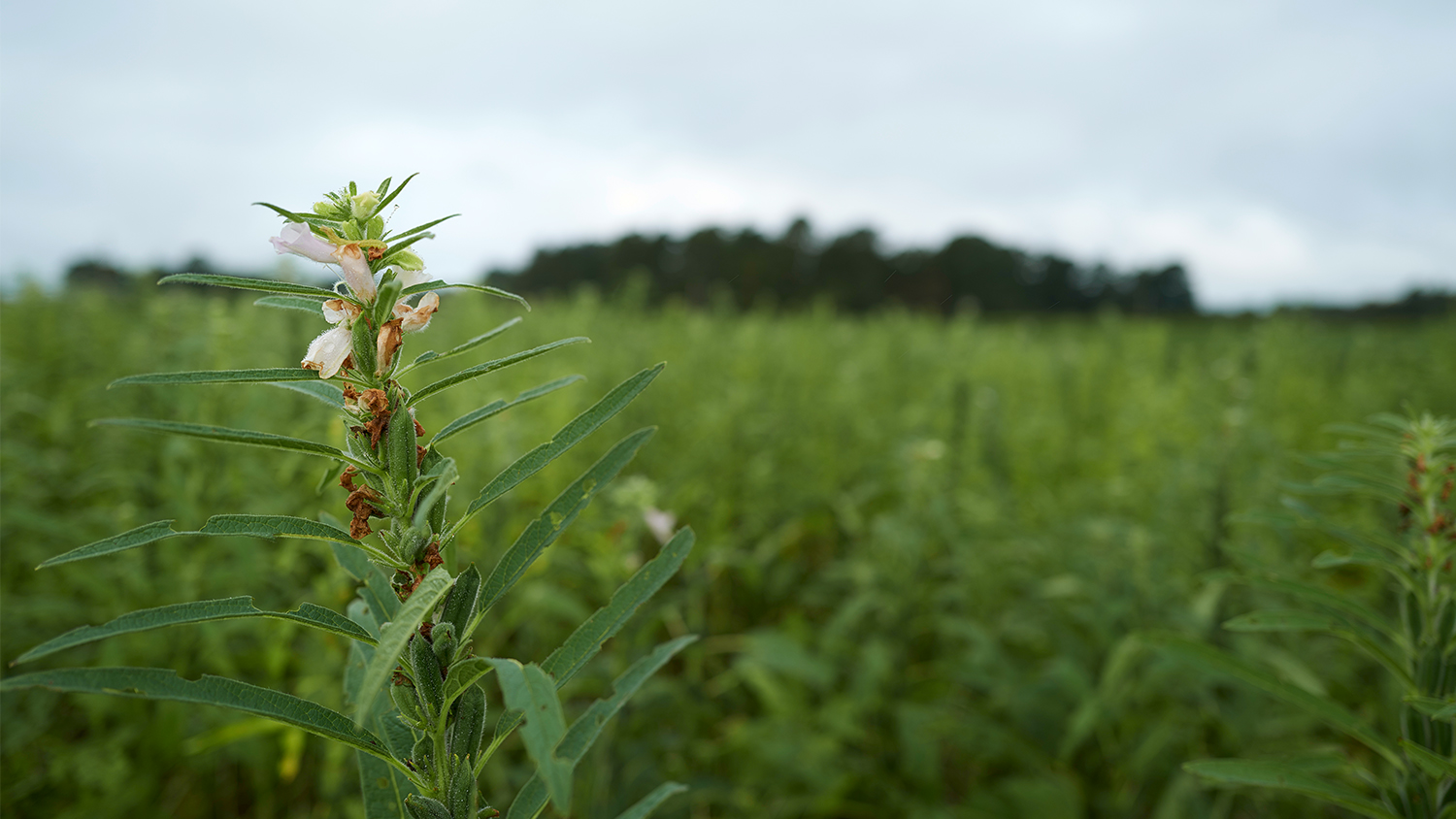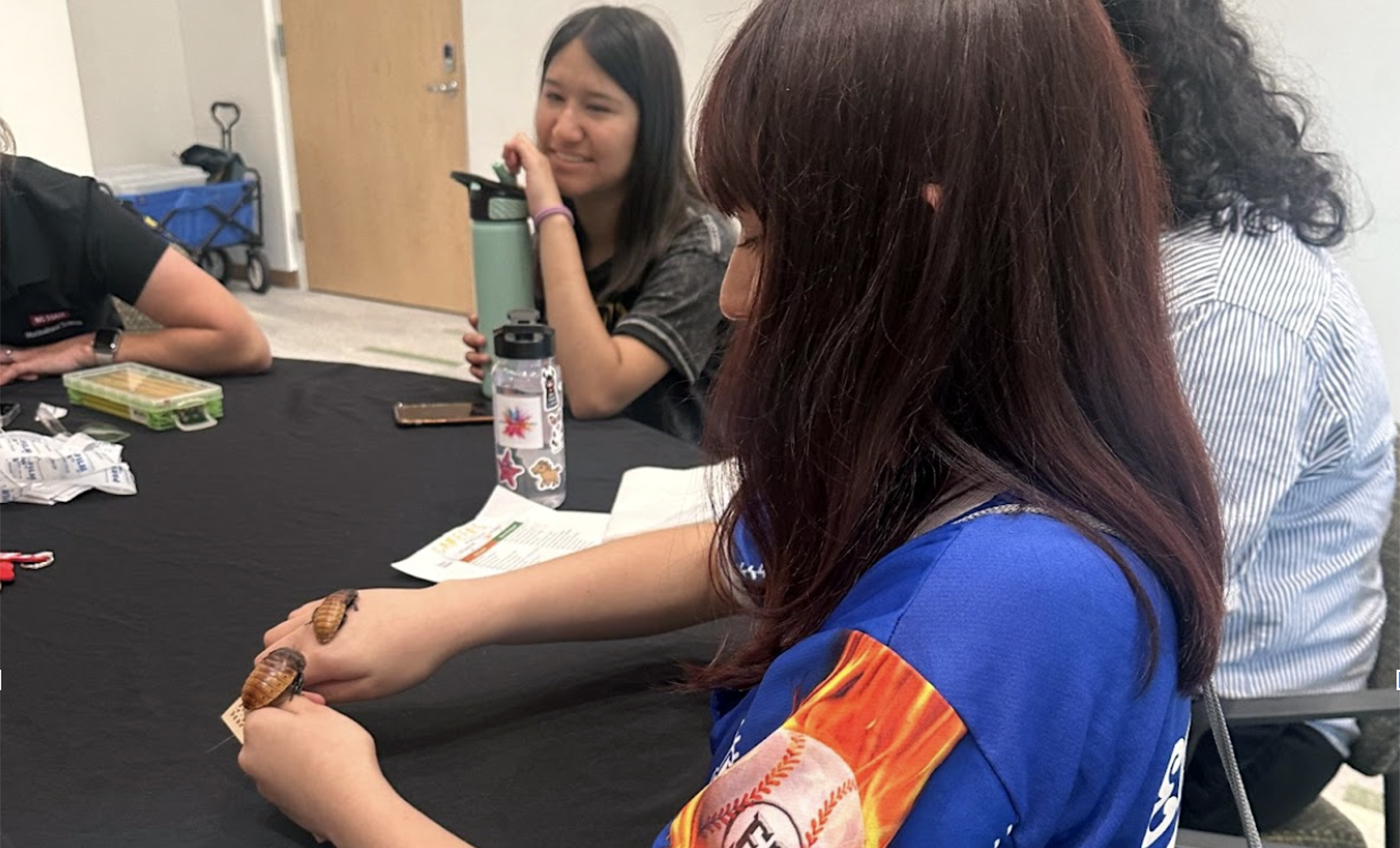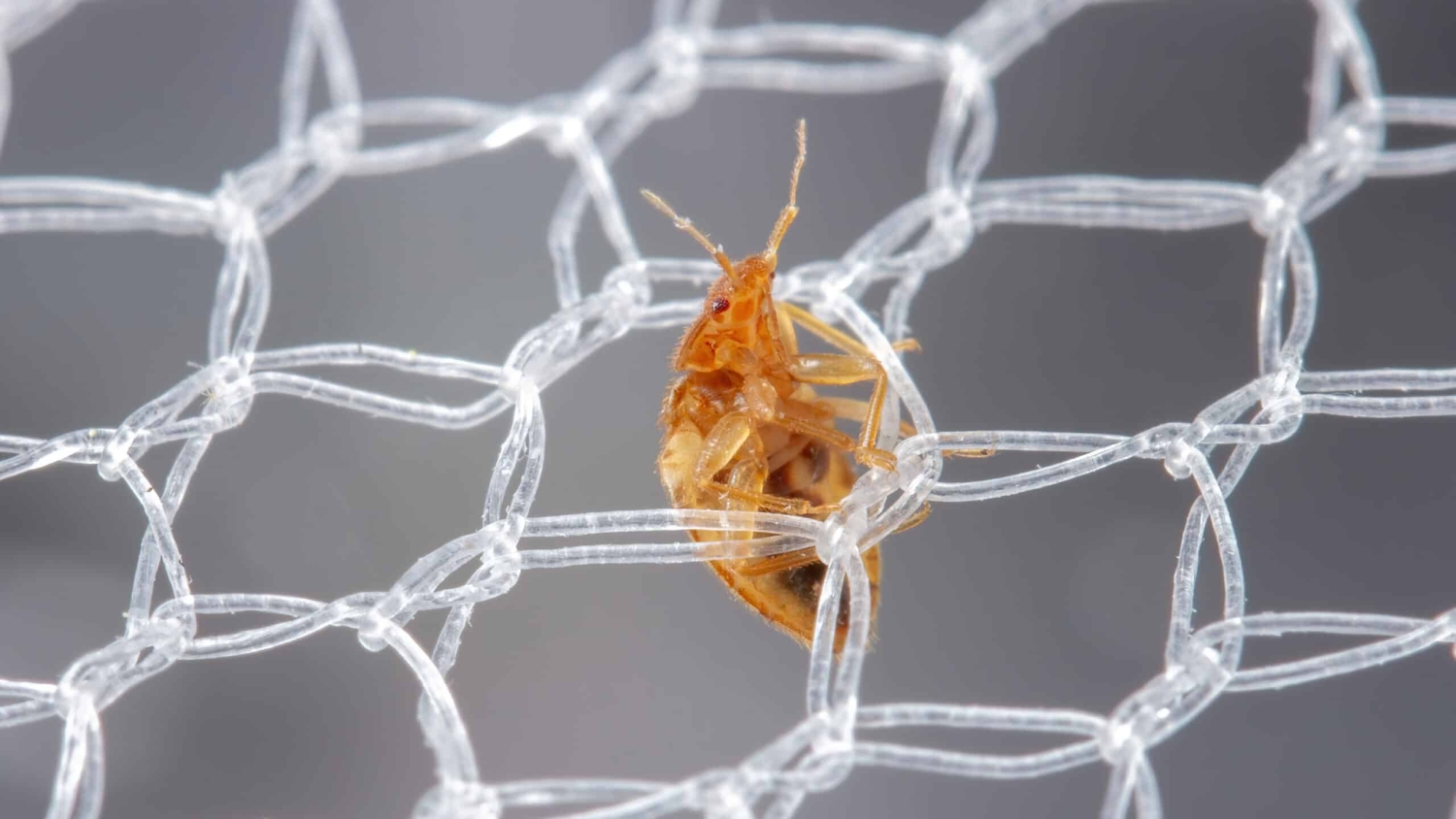Open Sesame Seeds

What are the magic words that would make you open to trying something new? Many of us are suckers for the words “free trial,” and with good reason. We get to try something new. If we don’t like it, we cancel it.
For a farmer interested in trying a new crop, a trial run is anything but free. If a crop fails there’s a real financial consequence. Enter David Suchoff. The alternative crops Extension specialist and NC State assistant professor of crop and soil sciences received a New and Emerging Crops Program grant from the North Carolina Department of Agriculture and Consumer Services that’s opening the door for farmers to test out sesame plants this spring and summer with little-to-no risk. The upside of this sesame trial: a potential economic boon for their farms.
Podcast Transcript
HOST:
What are the magic words that would make you open to trying something new? Many of us are suckers for the words “free trial,” and with good reason. We get to try something new., and if we don’t like it, we cancel it.
For a farmer interested in trying a new crop, a trial run is anything but free. If a crop fails there’s real financial consequences. Enter David Suchoff. The alternative crops Extension specialist and NC State assistant professor of crop and soil sciences received a New and Emerging Crops Program grant from the North Carolina Department of Agriculture and Consumer Services. It’s opening the door for farmers to test out sesame plants this spring and summer with little-to-no risk. The upside of this sesame trial: a potential economic boon for their farms.
SUCHOFF:
Adoption of a new crop by any farmer is a huge risk, right? There are a lot of unknowns. There’s a pretty steep learning curve associated with new crops, and farmers are spread very thin in terms of their time and resources. And so to add something on top of that, like a new crop, may not work for certain farmers, right? They’ve kind of got their hands full with everything else that they have to do. And so what we wanted to do with this project was really be able to de-risk potential early adoption of this crop.
And primarily the de-risking comes from covering a lot of the costs of the inputs, right? When a farmer tries to grow a new crop, that means that they’re going to be investing in it. They’re going to be paying for fertilizer and seed and herbicides and all these other things, and it may not work.
We wanted to incentivize farmers’ adoption of this crop by covering those costs so that if for some reason it didn’t work, they wouldn’t be out of pocket. And we are also going to be paying for their time as well. Ideally we’ll cover those costs, we’ll cover their time and they will sell the crop afterwards and make a profit. The de-risking of early adoption is really really important for these new emerging crops because it takes a lot for people to really want to try to grow something new with so many unknowns out there.
HOST:
Addressing those unknowns is part of Suchoff’s research mission. For the past two years, Suchoff and his research team have been testing sesame on small plot trials at NC State research stations. The studies demonstrated that sesame is a good fit for North Carolina; it can be grown throughout the Coastal Plain, Piedmont, Sandhills and the Tidewater regions.
SUCHOFF:
There were a lot of hard lessons learned. The one interesting thing about sesame is that even though it’s got a very small seed, you have to plant it very deep.
And traditionally, folks are taught that if it’s a big seed, you plant it deep. If it’s a small seed, you plant it shallow. Sesame kind of breaks that.
What we’re finding is that we need to plant it anywhere from one to one and a half inches into the ground, which is very very deep for any other small seeded crop. But what we’ve learned is that that seed needs to sit in moist soil for three days. If it is in moisture for two days and it dries up, the seed dies. So it’s gotta be three days to allow the seed to imbibe or take in that water and then, you know, get the root to emerge and start to grow.
Once it gets past that phase. It’s a very very tough crop. It’s drought-tolerant. It doesn’t really need a lot of inputs, but the planting is a little bit challenging and a little bit finicky compared to some of our other crops.
Some of the other kind of lessons that we learned in those small plot trials were that there are a number of sesame varieties that do well across North Carolina. So I think farmers have a good set of genetics or different cultivars that they could select from and should get good yields. We have also found that it’s a very plastic crop. And what I mean by plastic is that it kind of grows and fills the space that it’s given. And so we looked at different plant spacing, so spacing between rows, and we went from seven and a half inches, which is kind of traditional for a grain drill all the way up to 30 inches, which is going to be wider for a planter. And the interesting thing is that regardless of plant spacing, if we had the same plant populations, meaning the same number of plants per acre, we always got the same yield.
Didn’t matter if we did narrow planting or wide planting. And so what’s going on there is that plasticity. So plants that are grown in those very narrow rows will really just kind of be one single stem, and they’ll have the seed capsules along the stem. If you give them more space in that 30 inch row spacing, they tend to branch out more. And so they look a little bit more like bushes, and they’ll have capsules along those stems. But, at the end of the day, the yields are still the same. And this once again goes back to this idea of flexibility for the farmer. So if a farmer has a drill, they can use a drill. If they have a planter, they can use a planter. The spacing doesn’t necessarily affect yields that much. With all that said, we’re tending to promote the use of a planter at wide spacing versus a drill at narrow spacing because it allows for more weed management with this crop. The one thing that we have learned is that it is not a competitive crop with weeds.
The other really cool thing that we found, and this wasn’t necessarily a small plot trial, but it was in the greenhouse. My graduate student, Marcella Chavez, did a study where she was screening different sesame varieties against different root knot nematode species. Root knot nematodes are these microscopic worms that affect many many of our typical agronomic crops.
One that a lot of people have probably heard about lately is called the guava root knot nematode. It also impacts our sweet potato industry. And so there’s a lot of concern there. There’s not a lot of resistance there. And so Marcella screened the sesame varieties to guava root knot nematode as well as four other species. And she found that that sesame has resistance to all of these different nematodes. So it’s really exciting from a crop rotation standpoint. You know, if we have a field that has a history of nematodes, ideally we can plant this crop in there. We shouldn’t really see any damage to the crop, and we may actually potentially be able to reduce the native populations of nematodes, because if the nematodes don’t have anything to reproduce on, you can start to see a decline in that population.
We did one field trial this past year, and it was in a field with a pretty heavy root knot nematode population, and we produced a beautiful sesame crop. We really didn’t see any issues there. So certainly exciting and we’re hopeful to move forward with that. There’s a couple of other grants that my colleague Dr. Angela Post has in specifically looking at growing this crop in land infected with guava root knot. So we’re also hoping that with one of the farmer collaborators that we have in this current grant, through the NCDA, I think one of them will have some land with guava root knot nematode, and I think they wanna try planting sesame there. We’re gonna see if it works.
HOST:
The grant provides funds to help 10 farmers across a total of 100 acres. Suchoff did not have any trouble finding volunteers who also think sesame can be a viable alternative crop for North Carolina farmers.
SUCHOFF:
I must have been contacted by 30 or 40 different farmers who are pretty excited about this crop. It’s good to see the excitement, but it’s also a little frustrating because, you know, there are farmers that I had to turn away and say, you know, ‘Unfortunately we can’t cover you.’ There’s only so much money in the budget. But we are still seeing a lot of farmers that said, you know, regardless, they still plan to plant the crop. So I think we’re gonna see significant acreage this year, more acreage than we’ve ever had in the past, obviously. There are a lot of farmers that are quite interested in this crop. So I think this year is really going to be a good indicator of the real-world application of this crop and how well it actually does in our farming systems.
HOST:
Another plus about joining the sesame trial: besides the knowledge and the seeds, most farmers do not require any extra equipment to complete the trial.
SUCHOFF:
One of the things that we always like so that see in a new, emerging or an alternative crop is that it’s not going to require a significant investment in new equipment or specialized equipment on the farmer’s side. That’s not to say that farmers won’t buy that equipment if, you know, it’ll pay for itself basically, but to have a crop like sesame where we can use a planter or a drill that the farmer should have, as long as they have a combine to harvest it, that’s really all they need. So the only thing that we’re telling farmers is that you’re going to need to really check over your combine for any holes where those seeds can come through, because as you can imagine it’s a very, very small seed and it can certainly slip through some cracks that may not have been plugged up. But that is a huge selling point, is not having to invest in new equipment or any other types of inputs that farmers may not already be using or have.
HOST:
The other bonus is a built-in market for sesame and an industry partner ready to buy the sesame crop from the farmers.
SUCHOFF:
The main one that we’re working with right now is called Sesaco, and they do everything. They’re vertically integrated, they breed sesame, they sell sesame, they also purchase sesame or contract with farmers, and then they do sesame processing. And so what we’ve been doing is we meet with the farmer, we ask them how many acres they want to grow, and then we put them in direct contact with Sesaco so that they can then get that contract in writing. Sesaco is going to pick the seed up from the farmer. And Sesaco has traditionally been operating out in the West, so primarily in Texas and Oklahoma, but they simply can’t meet their demand there. And so there’s been this concerted effort to try and get more production in the Southeast. There’s production in Georgia, and now they’ve got their eyes on North Carolina. The price continues to go up. As I said, they can’t meet their demand, so it’s certainly exciting in that aspect.
HOST:
North Carolina farmers in the trial are primed to test out sesame and make a profit. Suchoff’s hope is North Carolina farmers will be able to produce a high-yielding, high-quality sesame crop that can compete with current production areas.
SUCHOFF:
It is very much a kind of large acreage agronomic crop, or a field crop. So this is going to be something that’s gonna be put in rotation with corn, soybeans, tobacco, sweet potatoes, cotton. This is not necessarily a crop that I see folks planting on really small acreage for, you know, say like within just a 10 or 15 acre vegetable farm. It’s not that type of crop. When you kind of look around the state and you look at what types of crops we grow, we grow a lot of corn, we grow a lot of tobacco, sweetpotato and soybeans. So, I think it’s got a really great fit in those types of operations.
HOST:
Thank you for joining us on Farms, Food and You. This podcast is a product of NC State Extension and the College of Agriculture and Life Sciences at North Carolina State University. If you would like to support the show, please share this episode on social media and leave a review on your podcasting app of choice. We’d love to hear from you. Let’s talk soon!
- Categories:


